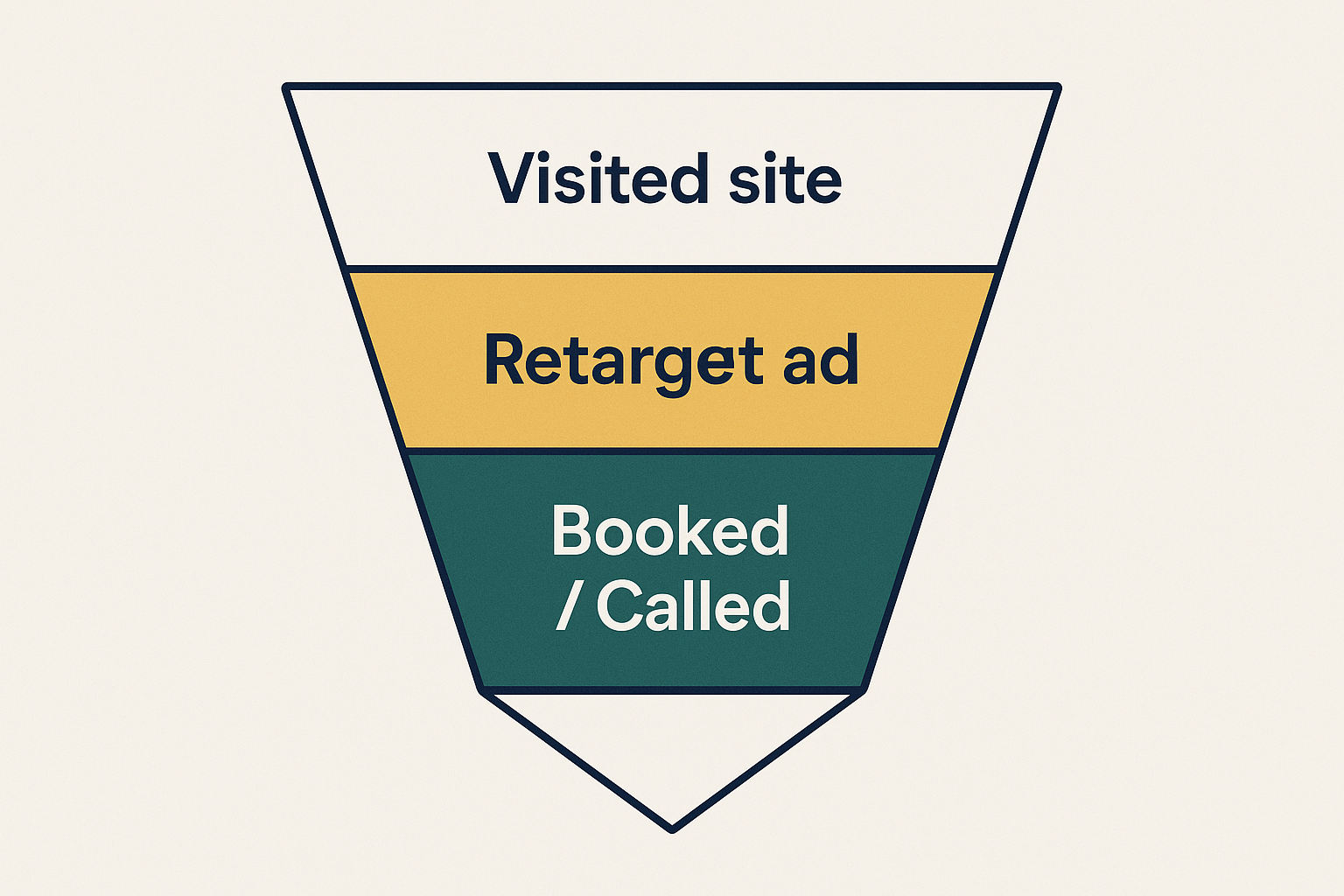Most visitors won’t book on the first visit to your site. Retargeting ads bring them back—with the right message for their stage in the client journey—so more people book, call, or request an estimate.
Done right, retargeting is the lowest‑risk ads strategy because it focuses on people who already showed interest in you and are a few steps away from booking your service.
This guide shows why retargeting matters, the audiences we build, how we create those audiences, how we produce the ads, and real use cases.
Why Retargeting is Important?
Turns intent into action
Most users are comparing options. The average user will take the time to do some basic research before choosing their provider. If you stay at their top of their head, you will be the first option it comes to mind when they are ready to make their decision.
Cheaper to convert
You’ve already achieved the hardest thing, getting them to your site. Retargeting squeezes more value from every user that visits your site or interacts with your content.
Message control
Most of the time users need for you to solve some of their concerns so they can make their decision. You can talk to them directly and solve the questions you know people usually have based on the stage of the client journey they are in.
Audiences Explained
One can generate audiences from different sources where people interact with your brand. Some examples are:
Website Visits
People who visited your site or specific pages.
Customer Journey Actions
People who started their customer journey but haven’t made the purchase (e.g., viewed scheduler, picked a slot, didn’t confirm).
Content Engagement
People who watched your video, engaged with your Instagram/Facebook/TikTok, or viewed your YouTube channel.
Customer/CRM Audiences
People in your database (past clients, leads) you want to re‑activate or up‑sell.
Exclusions
You can prevent wasting ad budget on people that are not making you any profit (e.g., people who already booked or people who don’t qualify for your service).
How We Create Audiences?
Step 1. Decide what to track
“What actions show interest and what actions show buying intent?”
- Interest
- Visited a service page
- Opened your booking calendar
- Read half the page
- Buying intent
- Confirmed a booking
- Sent an inquiry
- Tapped to contact
Step 2. Install Google Analytics 4
Goal: see traffic, basic engagement, and conversions (Key Events) in GA4.
A) Create GA4
- Go to analytics.google.com → create an Account and a Property (Web).
- GA4 will give you a Measurement ID like G-ABCD1234.
B) Add GA4 to your site (no code options)
- WordPress: Install Google Site Kit → Connect Analytics → pick your GA4 property.
- Shopify: In Admin → Preferences → Google Analytics, paste your GA4 Measurement ID.
- Wix / Squarespace / Webflow: Paste the GA4 Measurement ID in the site’s Analytics/Integrations settings.
- Custom site: Ask your dev to paste the GA4 gtag snippet.
Step 3. Install Meta Pixel (no code) and set events with the Event Setup Tool
Create & install the Pixel
A)Get the base code from Facebook.
- business.facebook.com → Events Manager → Connect Data Sources → Web → Meta Pixel
B)Paste the code to your site.
C)Choose your site → Use a partner (WordPress, Shopify, Wix, Squarespace, etc.)
D)“Install code manually” (paste the base code in your site’s header settings).
Step 4. Build engagement audiences in Meta (free warm traffic)
Where to find the Audiences builder in Meta Business Suite:
Meta Ads Manager → All Tools → Audiences → Create Audience → Custom Audience
You can create audiences out of the following sources:
- Video Viewers: People who watched 25%+ (or 50%/95%) of your videos in the last 30–90 days.
- Instagram Account Engagers: Anyone who engaged with your IG (30–90 days).
- Lead Form Engagers: Opened a lead form but didn’t submit (last 30 days).
- Facebook Page Engagers: Interacted with your Page (30–90 days).
Use Cases "What This Looks in Real Life"
Audiences:
Create an Audience that includes people that meet any of the following criteria:
- Service viewers last 30 days
- Started request quote form and didn’t submit.
- Requested a quote and didn’t purchase the service.
Ads:
Build a video out of any of these 4 options to use as our ad.
- 3‑panel before/after
- Warranty/insurance badges
- Free same‑week estimate
- Insurance claim assistance.
Destination:
All of the traffic created from the ad should be sent to a place where we can optimize for conversion. Usually that means the landing page to the specific action we want them to do. In this case is to book our services, therefore we are going to send them to the booking page directly.

